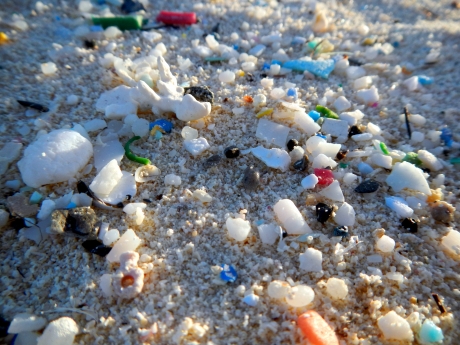Microplastic Researchers Seek to Understand Atmospheric Transport
May 31, 2022
May 31, 2022
Plastic is everywhere: from food wrappers to bags and even tires. One study estimates that 11% of plastic waste generated in 2016 entered the ocean, with this estimate expected to increase to 53 million metric tons per year by 2030. When plastic products deteriorate, they form small particles called microplastics. Particles range in size, but microplastics are under five millimeters in size, or about the size of a pea. Scientists have found microplastics almost everywhere: shellfish, remote fields, arctic snow, drinking water, and all types of waterways.
These tiny particles can migrate far and quickly. While microplastics in the oceans have been studied rather extensively, few studies have focused on how they arrive in the ocean, which is often through atmospheric transport. Microplastic particles are small and light, so they are easily transported by air. Airborne microplastics can travel to remote locations in mere days or weeks.
Understanding why microplastics concentrations differ will help to predict and mitigate their impact. For example, cities are a source of microplastics due to human activities, transportation and waste. Although some measurements have been made, the concentrations of atmospheric microplastics vary widely across the world: from 0.9 MP per cubic meter in Paris outdoor air to 5,700 MP per cubic meter in Beijing outdoor air.


The effect of microplastics on human health is just beginning to be understood – humans are exposed by inhaling particles or through the food web, such as food packaging, seafood ingestion, agriculture. Human exposure to microplastics are a challenge to sustainability goals and offer health consequences that have yet to be fully understood. Marine research shows the tenacious persistence of plastic material in both marine creatures and humans.
In a Nature Reviews article, working groups from the Joint Group of Experts on Scientific Aspects of Marine Environmental Protection, GESAMP, reports on ways to understand where microplastics originate, how quickly they are transported and where they may end up. A number of processes that transport microplastics are not well understood, such as: how are they captured in sea spray or condensed water; how do they interact with other chemicals in the atmosphere; and what happens as they degrade?
The paper outlined the need for a global network that not only measures microplastics concentrations, but also models behavior. The instrumentation would include sampling towers and atmospheric samplers both on the coastline and the land/sea interface. Sampling of lower atmospheric microplastics can be done with uncrewed aerial vehicles for cost efficiency, along with a standard measurement technique so that data sets are comparable across continents. The proposed observation stations are located around the globe. A standardized observatory that can sample or replicate these processes simply is not yet available and requires a global reach to account for geographical, meteorological, and environmental factors.
Modelling how microplastics get transported is another key to decipher the process, and that’s where NOAA’s Air Resources Laboratory comes in. Studies of atmospheric microplastics often use ARL’s HYSPLIT to model the transport of air parcels. HYSPLIT can identify the potential source of pollutants such as microplastics, and the trajectory it may have traveled (distance, elevation, atmospheric mixing etc.). However, the model currently works best with large particles, and has not been optimized for microplastics, which are smaller and lighter than most atmospheric pollution.
“We are just scratching the surface on this topic, there is a great degree of uncertainty in measurements and models that need to be reduced in order to quantify the magnitude of the microplastic problem, said Ariel Stein, Director of NOAA’s Air Resources Laboratory. NOAA Research is well positioned to help address many of these needs. Adds Stein: “We need to expand and improve current measurement and modeling techniques to better tackle this issue.”